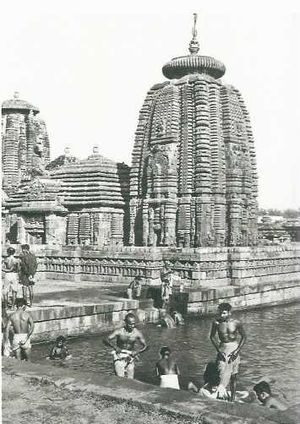Talk:Bhuvaneśvara
By Swami Harshananda
Bhuvaneśvara literally means the city of the Lord of the world’.
Geographical Location of Bhuvaneśvara[edit]
Bhuvaneśvara, the modern capital of the State of Orissa (India), is an ancient place of pilgrimage called ‘Bhuvaneśvara’ or ‘Ekāmratīrtha’ in the purāṇas. It is situated in the Khurda subdivision of the Puri district and is 440 kms. (286 miles) from the city of Calcutta.
Historical Significance of Bhuvaneśvara[edit]
Bhuvaneśvara was a great center of Śaivism in the Kaliṅgadeśa (now Orissa) and was often considered as a rival of Vārāṇasī (the modern Banāras, the most celebrated of all the Śaiva places of pilgrimage). It was also a center of Buddhism for some time. The remnants of this religious cult can still be found in the hills of Udayagiri and Khaṇḍagiri.
Religious Significance of Bhuvaneśvara[edit]
Initially the city had seven thousand shrines surrounding the famous Bindusāgara or Gosāgara lake. But now it hardly has a hundred of them. Though the city of Puri (better known as Jagannātha Puri or Jagannātha-kṣetra) is now much more well-known and most visited pilgrimage, the tradition is that one who wishes to visit Jagannātha Puri must first make a pilgrimage to Bhuvaneśvara. Even Srikṛṣṇa Caitanya (A. D. 1485-1533) the great Vaiṣṇava saint, is said to have had the darśan of Lord Liṅgarāja of Bhuvaneśvara first before proceeding to Puri.
Tradition of Worship in Bhuvaneśvara Temples[edit]
A pilgrimage to Bhuvaneśvara starts with a ceremonial bath and śrāddha[1] at the Bindusāgar, a lake measuring 420 by 330 meters (1400 ft. by 1100 ft.). It is believed to have been dug out by Lord Śiva himself to quench the thirst of Pārvatī, his consort. A little water from all the sacred rivers is being drawn into it. After worshiping Gaṇapati, Gopālinī (Pārvatī as a cowherdess), Skanda and Nandi in the nearby shrines, the pilgrim is advised to enter the temple of Liṅgarāja to offer his worship there.
History and Description of Liṅgarāja Temple[edit]
The great Liṅgarāja temple was built around A. D. 1000. It is acclaimed as the finest example of a temple of the Nāgara style in eastern India. It stands amidst a cluster of 65 smaller shrines in a spacious compound measuring about 160 by 140 meters (530 ft. by 460 ft.). The tower is nearly 55 meters (180 ft.) high. The temple consists of the garbha-mandir, the sanctum sanctorum, also called ‘Srīmandir’ with a hollow vimāna (small tower) over it. The Bindusāgara is situated to the north of the temple.
Śivaliṅga in the Liṅgarāja Temple[edit]
The image of Śiva is a liṅga which is a huge uncarved block of granite, about 2.4 meters (8 ft.) in diameter surrounded by a rim of black chloride. The image itself is called as ‘Liṅgarāja,’ ‘Tribhuvaneśvara’ or ‘Kṛttivāsa’. Daily worship is done 22 times, water, milk and bhāṅg (Indian hemp) being used to bathe the liṅga.
Different Temples Around the Liṅgarāja Temple[edit]
Other temples situated in the vicinity are those of Ananta-Vāsudeva, Rāja-Rāṇi, Mukteśvara, Paraśurāmeśvara, Siddheśvara and Kedāreśvara. Out of these, the Mukteśvara temple, though small, is considered to be very beautiful with elaborate carvings.
Tourist Attraction Around Bhuvaneśvara[edit]
Situated at a distance of about 5 kms. (3 miles) from Bhuvaneśvara, are the hills Udayagiri, Khaṇḍagiri and Nīlagiri containing as many as 66 caves. There are many carvings of Hinduism and Buddhism.
References[edit]
- ↑ śrāddha: obsequial offerings to departed manes
- The Concise Encyclopedia of Hinduism, Swami Harshananda, Ram Krishna Math, Bangalore


